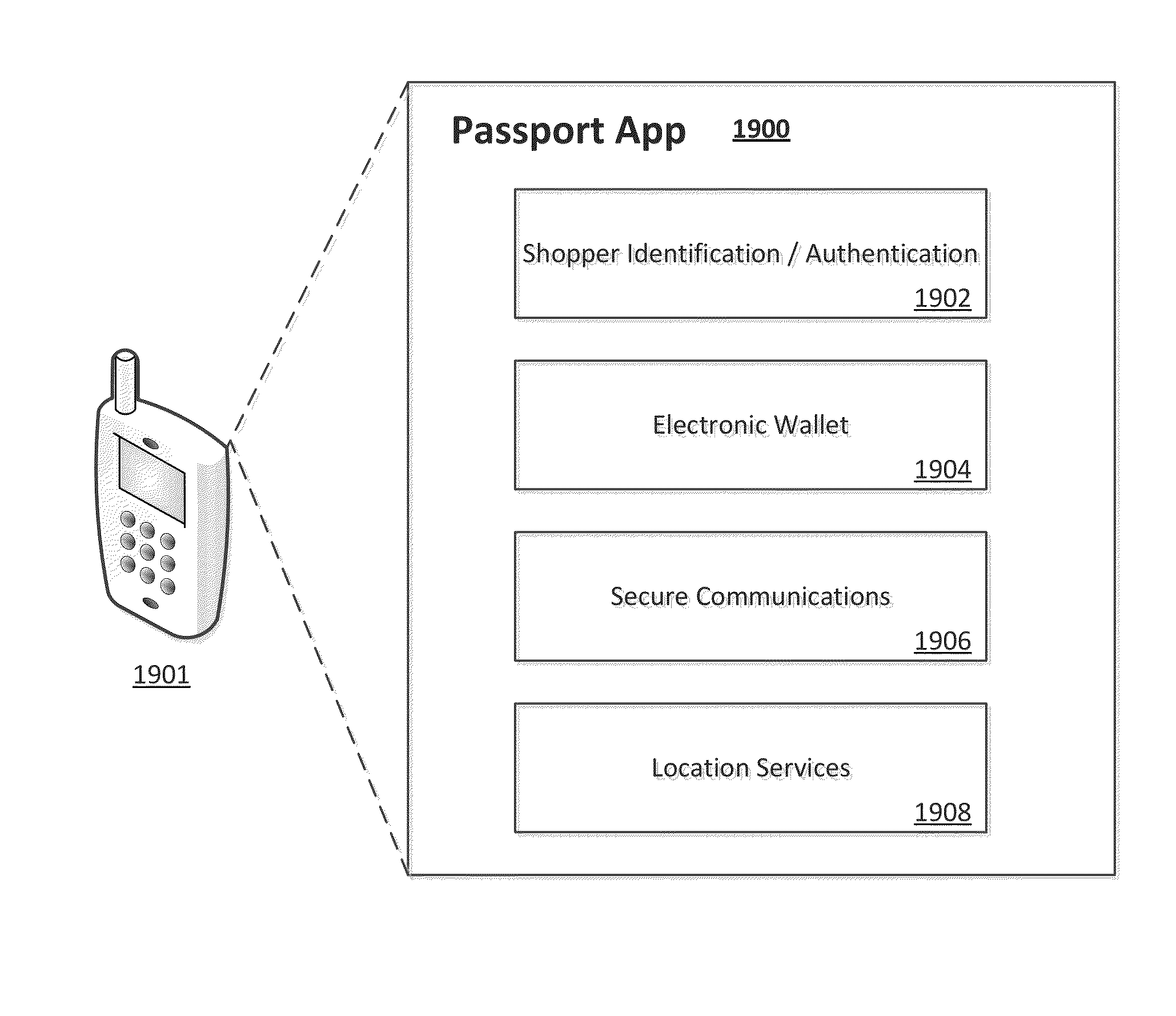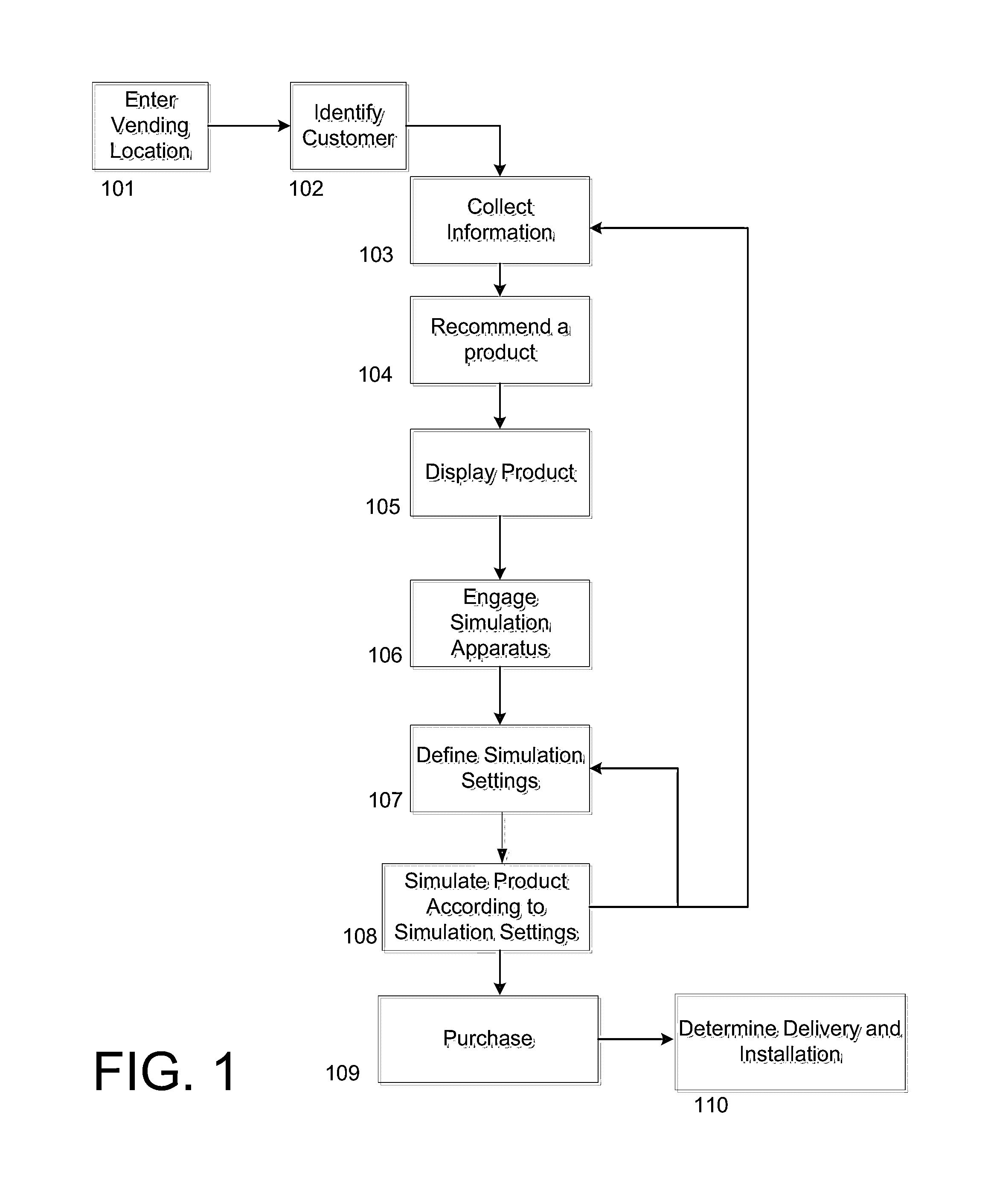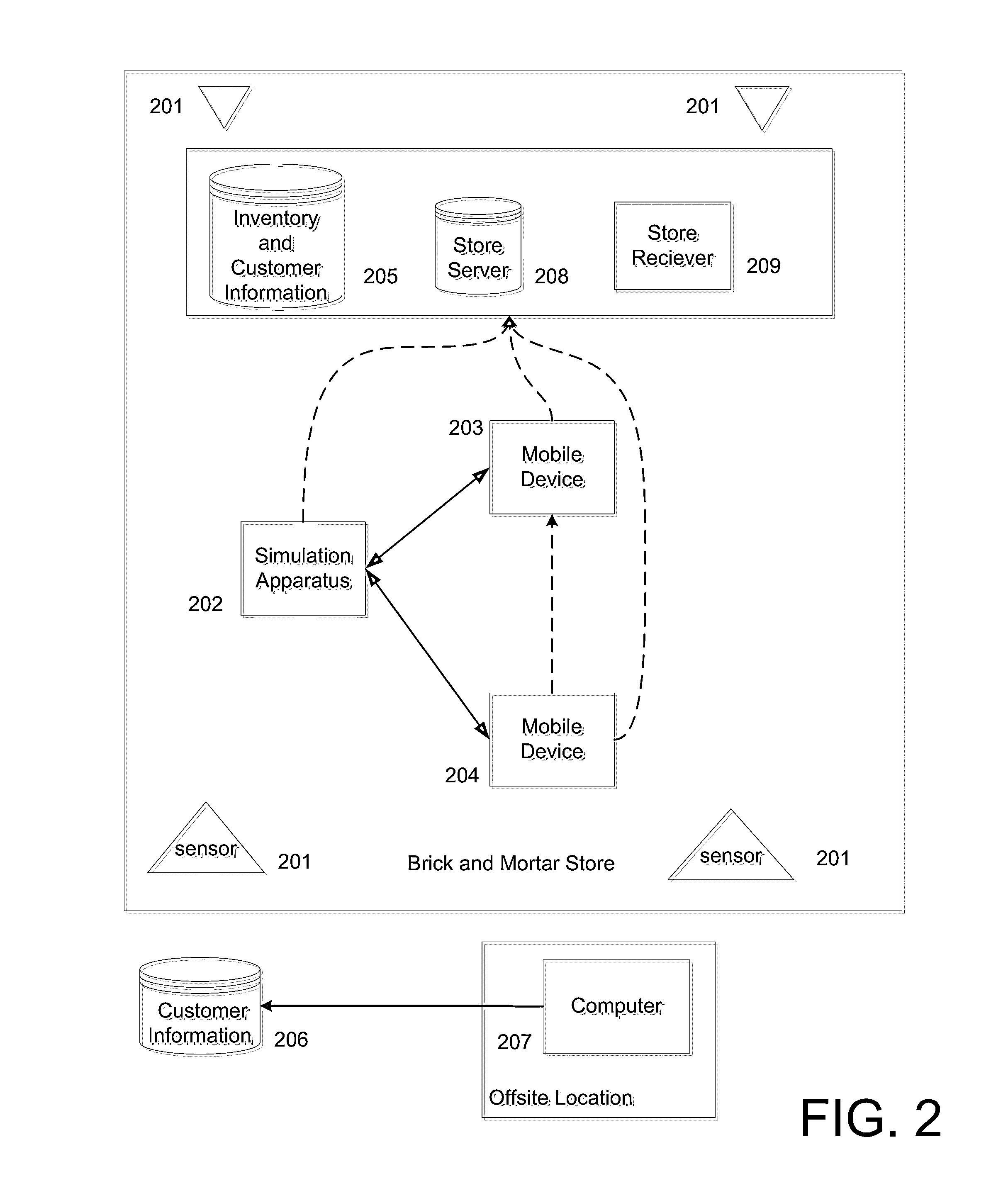Today, retailers with large inventories and
limited resources find it difficult to provide customers with a customized sales experience.
The physical constraints of the size of physical (e.g., “
brick and
mortar”) stores typically limit the amount of products retailers can physically shelve and store on site.
These physical constraints also typically
impact the retailer's ability to effectively display and demonstrate their products to their customers.
Other limitations, such as limitations on the number of customers sales representatives retailers can employ on site, typically
impact a retailer's ability to answer customer questions, collect information about the customer, and make recommendations for products or services.
Retail stores with large inventories of products typically require a large amount of
physical space to shelve, and store their goods.
As a result, retail stores with limited amounts of
physical space typically do not have the benefit of displaying most of their inventory.
These retail stores may resort to shelving or displaying only a fraction of their entire line of goods, which may only appeal to a small subset of the vendor's customer base.
This is problematic for vendors because it limits a vendor's ability to customize the sales process to the particular needs and traits of a customer.
However, this creates a problem for vendors who do not have enough
physical space to keep that product stored or shelved in inventory; those vendors may not have the
advantage of providing a truly customized sales experience to the customer.
That is, retail stores with limited physical space may not have the capability of customizing the sales experience to every segment of their customer base.
However, retail stores with limited physical space find it difficult to provide a tangible, interactive experience for the full range of their products in terms of look-and-feel within the home.
Although retail stores sometimes provide product catalogs that describe most of their goods, these catalogs do not provide the same tangible experience as being able to physically interact with a product; customers normally will not have the benefit of estimating how the product may look, feel, or integrate in their home.
Generally, retail stores do not typically provide an intuitive interface that allows customers to interact with in-store displays.
However, touch screen interfaces for these mobile devices are not suitable for the in-store shopping experiences because of their smaller size and limited display capabilities.
Thus, retailers find it difficult to adapt the intuitive touch or gesture interfaces used for mobile devices to large in-store displays.
Accordingly, retailers find it difficult to create retail fixtures that integrate sensors and retail devices in a reusable and modular manner.
However, retail stores are typically limited in the number of skilled, career-oriented sales representatives they can employ to assist and engage with customers.
Sometimes,
high turnover or transient career opportunities at retail stores causes sales representatives to have little training and limited experience.
Thus, retail stores usually only provide truly individualized assistance to a fraction of potential buyers who enter the store.
However, these demonstration spaces typically do not reflect the environment the customer intends on using the products accurately.
Thus, the customers do not typically appreciate how a particular product, such as a television or speaker, may look or feel in their particular intended environment while at the retail store.
Normally, sales representatives do not have access to any other information about the customer other than what they can directly observe, limiting their ability to provide customized recommendations for products.
While this information would improve the sales process, vendors generally find it difficult to provide this non-
observable, previously stored
customer information to the sales representatives during the in-store sales process.
But as of yet, such
customer information has not been truly integrated into the sales process so as to improve the relevance and appeal of the vendor's recommendations to its customers in a manner that accommodates reductions in floor space and the number of in-store representatives.
Moreover, to the extent retail stores use information about a customer, retail stores typically do not incorporate this information into the sales process in real-time.
While online retail stores may avoid some of these problems, online retail stores typically do not allow vendors to monitor the customers or provide in-person assistance the same way they could as with a physical store.
For example, the information presented to a customer on an online retail website may be overwhelming or difficult for the customer to digest without a personal sales representative.
Moreover, vendors typically cannot monitor a customer's body language or social cues while the customer is shopping online, limiting the amount of information the vendor has to make a recommendation for a particular product to the customer.
For example, if a customer likes a product they viewed in a store, retail stores typically do not provide a way to track this information so that the
consumer can later decide to learn more about the product or purchase the product after leaving the store.
Likewise, retail stores typically do not integrate
customer information collected from their online website, such as the customer's online shopping history, into the in-store sales process.
For example, retail stores do not typically access a customer's online shopping history to recommend a product when the customer makes a visit to the physical store.
Accordingly, there is a deficiency in terms of the lack of integration or synthesis of information from online retail stores and physical stores to improve the sales process.
Because vendors usually require a customer to create an account, vendors typically cannot make recommendations to new customers visiting their online website for their first time, or who have not yet registered an account with the vendor.
Similarly, because vendors usually require a customer to allow the website to store information locally to a browser's cache, vendors typically cannot make recommendations to new customers with strict privacy control settings that forbid websites to store information to their cache.
However, online retail websites generally do not have a way to gather information that may be used for determining a customer's demographic or psychographic information without directly asking the customer for this information.
Similarly, vendors have difficulty in deriving helpful psychographic and demographic characteristics in other alternative channels of commerce.
However, vendors are typically limited in the manner they may determine a customer's psychographic or demographic characteristics shopping via these alternative channels of commerce.
Unlike the physical store context, these channels of commerce typically do not allow vendors to visually determine these characteristics with sales representatives, or detect these characteristics through the use of sensors.
In physical retail stores, i.e., physical stores, vendors often do not guide customers through the sale process from a single location.
Performing the different steps of the sales process at different locations and by different store personnel can create various costs and inefficiencies as the person of ordinary skill will readily appreciate.
For the customer, it can provide a fragmented sales experience that undermines customer satisfaction and repeat sales.
The inability to guide a customer through the stages of the sales process from a single location is further problematic because it places a limit on the vendor's ability to operate in a
confined space.
Thus, vendors often cannot provide this entire range of services in retail locations that require a small amount of space, such as an information kiosk at an air airport.
This, in turn, typically limits the range of locations vendors can create a physical retail presence.
Unfortunately, despite the great advances in computing and Internet technologies, today's retail shopping process still resembles what it was like in the 20th century and does not provide for a seamless, individualized discovery and shopping experience.
For example, today's retail stores have a number of structural problems that frustrate shoppers.
Such problems include but are not limited to: inability to seamlessly integrate discovery from home with additional in-store discovery and shopping; inability to seamlessly integrate in-store discovery with additional in-home discovery and shopping; poorly trained salespeople; a vast selection of merchandise spread over a large area; the need to travel to store to check-out and to determine the availability of post-sale services (in addition to the need to travel to store to shop); products grouped by type (e.g., TV receivers, men's sports coats, etc.) and not grouped by solution (e.g., home theaters, men's outfits, etc.); inability to perform cross-departmental product demonstrations (e.g., take a picture with a particular camera and display it on a particular TV in the store); merchandise being displayed for a generic shopper and not for the individual shopper; merchandise being displayed and demonstrated in the store environment as opposed to the users' actual environments; inability to see products in detail (e.g., rear panel of a TV set or AV
receiver,
cut-away of competitive oil filters, etc.); inability to obtain customized product content, including displayed comparisons of selected products; and inability to by-pass a sales advisor when greater technical expertise is immediately required (e.g., Apple Store's Genius Bar requires an appointment).
Today's retail stores also have several structural problems that are very problematic for the retailers themselves.
Such problems include but are not limited to: difficulty retaining experienced and knowledgeable salespeople, resulting in a poorly trained sales force; the need to carry more merchandise as product manufacturers, categories and assortments grow; the need to reduce the size of stores; difficulty providing adequate store
staffing during peak seasonal periods; inability to offer a customized sales experience that targets the shoppers' individual demographic and psychographic profile; inability to understand shoppers' in-home discovery, often with little to no knowledge of shoppers' past shopping and buying history; inability to provide shoppers with individualized information which they can reference in making additional in-home discovery and / or deferred shopping decisions, including detailed technical comparisons of products that are of particular interest to an individual shopper; difficulty of sales advisors to access a company's vast
database of product and educational information without leaving the customer; inability to demonstrate products in the shoppers' exact
user environment (e.g., how a particular speaker will sound in their
living room or car); inability to offer shoppers with a virtual shopping
cart that fully integrates their in-home and in-store discovery shopping processes; inability to schedule post-sales services at the
point of sale; inability for sales advisors to control the discovery and shopping environments from their portable smart devices; inability to post real-time price changes and
customer reviews; and inability to obtain real-time analytics regarding their shoppers' discovery and shopping behavior.
Other problems and drawbacks also exist.
 Login to View More
Login to View More  Login to View More
Login to View More 


